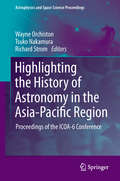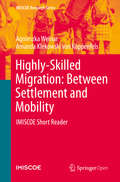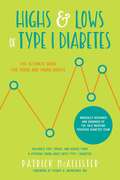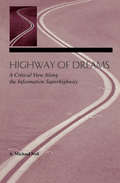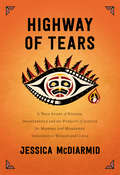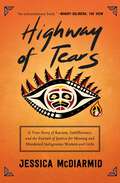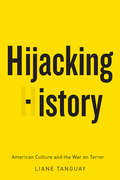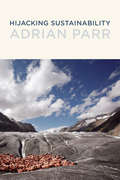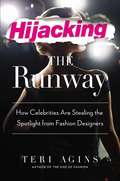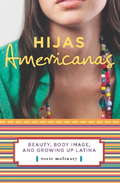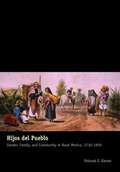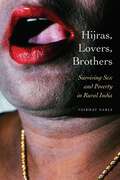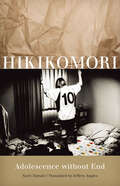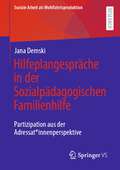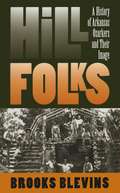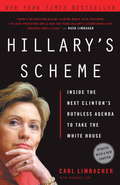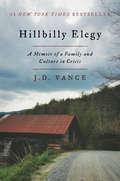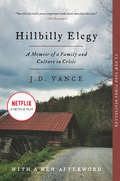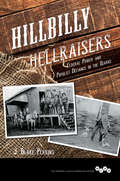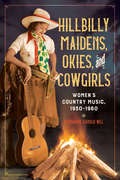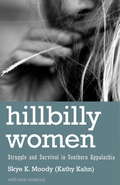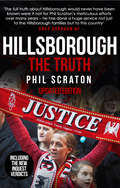- Table View
- List View
Highlighting the History of Astronomy in the Asia-Pacific Region
by Richard G. Strom Wayne Orchiston Tsuko NakamuraWith just 400 pages, this title provides readers with the results of recent research from some of the world's leading historians of astronomy on aspects of Arabic, Australian, Chinese, Japanese, and North and South American astronomy and astrophysics. Of particular note are the sections on Arabic astronomy, Asian applied astronomy and the history of Australian radio astronomy, and the chapter on Peruvian astronomy. This title is of particular appeal to those with research interests in applied historical astronomy; archaeoastronomy; calendars, manuscripts, and star charts; historical instruments and observatories, and the history of radio astronomy.
Highly-Skilled Migration: IMISCOE Short Reader (IMISCOE Research Series)
by Agnieszka Weinar Amanda Klekowski von KoppenfelsThis open access short reader discusses the emerging patterns of sedentary migration versus mobility of the highly-skilled thereby providing a comprehensive overview of the recent literature on highly-skilled migration. Highly-skilled migrations are arguably the only non-controversial migrant category in political and public discourse. The common perception is that highly-skilled migrants are high-earners with top educational skills and that they are easy to integrate. These perceptions make them a “wanted” migrant. There seems to be however a big divide between the popular perceptions of this migration and its realities uncovered in social research. This publication closes this divide by delving deeper in the variety of experiences, discourses and realities of highly skilled migrants, thereby uncovering the inherent divides between the highly skilled migrants from the North and the South. The reader shows that these divides are constructed realities, shaped by the state policies and underpinned by social imaginary. Written in an accessible language this reader is a perfect read for academics, students and policy makers and all those unfamiliar with the topic.
Highs & Lows of Type 1 Diabetes: The Ultimate Guide for Teens and Young Adults
by Patrick McAllister Stuart AValuable tips, tricks, and advice from a veteran young adult with Type 1 diabetes. Type 1 diabetes (T1D) can be a daunting diagnosis, especially for a young kid or a teen. Patrick McAllister knows. Diagnosed with T1D at age twelve, McAllister’s life changed forever, and he faced an uncertain future of insulin shots, diet regulations, and high school. If only I had a roadmap, he thought. So, years after he learned things the hard way, he decided to write one.Whether it is managing mood swings, hormones, or blood sugar levels, Highs & Lows of Type 1 Diabetes is the ultimate teenager’s and young adult’s handbook for surviving, thriving, and flourishing with T1D during one of the most terrifying, yet exciting, phases of your life. Many think of T1D as a scary disease that is sporadic and uncontrollable, but after eight years of dealing with the literal and figurative highs and lows of T1D, McAllister has learned that it is more a lifestyle change. These pages detail a framework for every situation you could possibly imagine involving T1D, from coming home from the hospital after your diagnosis to preparing to leave your nest for freshman year at college. Learn how to:Count carbohydrates, pump insulin like a pro, and correct irregular blood sugar levelsTell your friends, get good grades, and survive schoolPlay sports with the right game-planNavigate sex, drugs, and rock ‘n’ rollAnd more!Type 1 diabetes stinks, but you don’t have to go through it blind and alone! Some have learned it the hard way, but Highs & Lows of Type 1 Diabetes will ensure that you will take control of your T1D diagnosis, conquer your adolescent years, and live a healthy and fulfilling life.
Highway of Dreams: A Critical View Along the Information Superhighway (LEA Telecommunications Series)
by A. Michael NollThis important volume reviews the history of the telecommunication superhighway pointing out its beginnings in the interactive TV and broadband highway of the wired cities more than two decades ago. It explains the technological uncertainties of the superhighway and many of its futuristic services, and also gives an understandable review of the technological principles behind today's modern telecommunication networks and systems. Recognizing that technology is only one factor in shaping the future, the author, a well-recognized telecommunications expert, analyzes the financial, policy, business, and consumer issues that undermine the superhighway. The book concludes by showing that today's switched telephone network and CATV systems already form a telecommunication superhighway carrying voice, data, image, and video communication for a wide variety of services that enable us to stay in contact with anyone anywhere on our planet. Highway of Dreams is written clearly with understandable explanations for nonspecialists. It challenges the technological utopia offered by the promoters of the superhighway and suggests that consumer needs, finance, corporate culture, and policy often have far greater impact on the future than technology alone.
Highway of Tears: A True Story of Racism, Indifference and the Pursuit of Justice for Missing and Murdered Indigenous Women and Girls
by Jessica McDiarmidA penetrating and deeply moving account of the missing and murdered Indigenous women and girls of Highway 16, and a searing indictment of the society that failed them.For decades, Indigenous women and girls have gone missing or been found murdered along an isolated stretch of highway in northwestern British Columbia. The highway is known as the Highway of Tears, and it has come to symbolize a national crisis.Journalist Jessica McDiarmid meticulously investigates the devastating effect these tragedies have had on the families of the victims and their communities, and how systemic racism and indifference has created a climate where Indigenous women and girls are over-policed, yet under-protected. Through interviews with those closest to the victims--mothers and fathers, siblings and friends--McDiarmid provides an intimate, first-hand account of their loss and unflagging fight for justice. Examining the historically fraught social and cultural tensions between settlers and Indigenous peoples in the region, McDiarmid links these cases to others across Canada--now estimated to number up to 4,000--contextualizing them within a broader examination of the undervaluing of Indigenous lives in the country.Highway of Tears is a piercing exploration of our ongoing failure to provide justice for missing and murdered Indigenous women and girls, and testament to their families and communities' unwavering determination to find it.
Highway of Tears: A True Story of Racism, Indifference, and the Pursuit of Justice for Missing and Murdered Indigenous Women and Girls
by Jessica McDiarmid&“These murder cases expose systemic problems... By examining each murder within the context of Indigenous identity and regional hardships, McDiarmid addresses these very issues, finding reasons to look for the deeper roots of each act of violence.&” —The New York Times Book Review In the vein of the bestsellers I&’ll Be Gone in the Dark and The Line Becomes a River, a penetrating, deeply moving account of the missing and murdered indigenous women and girls of Highway 16, and a searing indictment of the society that failed them. For decades, Indigenous women and girls have gone missing or been found murdered along an isolated stretch of highway in northwestern British Columbia. The corridor is known as the Highway of Tears, and it has come to symbolize a national crisis. Journalist Jessica McDiarmid meticulously investigates the devastating effect these tragedies have had on the families of the victims and their communities, and how systemic racism and indifference have created a climate in which Indigenous women and girls are overpoliced yet underprotected. McDiarmid interviews those closest to the victims—mothers and fathers, siblings and friends—and provides an intimate firsthand account of their loss and unflagging fight for justice. Examining the historically fraught social and cultural tensions between settlers and Indigenous peoples in the region, McDiarmid links these cases to others across Canada—now estimated to number up to four thousand—contextualizing them within a broader examination of the undervaluing of Indigenous lives in the country. Highway of Tears is a piercing exploration of our ongoing failure to provide justice for the victims and a testament to their families&’ and communities&’ unwavering determination to find it.
Hijacking History
by Liane TanguayIn Hijacking History, Liane Tanguay unravels the ideology behind an American enterprise unprecedented in scope, ambition, and brazen claim to global supremacy: the War on Terror. She argues that the fears, anxieties, and even the hopes encoded in American popular culture account for the public's passive acceptance of the Bush administration's wars overseas and violation of many of the rights, privileges, and freedoms they claimed to defend. In her analysis, Tanguay critically examines the neoconservative contention that the current system of liberal-democratic capitalism represents the peak of human evolution - a claim that creates the impression of a "post-historical" age. Establishing a continuity between the "post-historical" imaginary and the attacks of 9/11, the book examines the links between shifting justifications for the war, renewed militarism, and capitalist globalization. Reviewing a wide range of media including Hollywood films, network television, and presidential rhetoric, Tanguay calls for a revival of politics in popular culture and rejects the politics of fear as disseminated by mass media. A timely retrospective on the War on Terror, Hijacking History examines popular representations of US military action and dissects both the logic and the aesthetics by which the dominant discourses strive to justify war, while revealing how some of those forces can ultimately contribute to an ideology of resistance.
Hijacking History: American Culture and the War on Terror
by Liane TanguayIn Hijacking History, Liane Tanguay unravels the ideology behind an American enterprise unprecedented in scope, ambition, and brazen claim to global supremacy: the War on Terror. She argues that the fears, anxieties, and even the hopes encoded in American popular culture account for the public's passive acceptance of the Bush administration's wars overseas and violation of many of the rights, privileges, and freedoms they claimed to defend. In her analysis, Tanguay critically examines the neoconservative contention that the current system of liberal-democratic capitalism represents the peak of human evolution - a claim that creates the impression of a "post-historical" age. Establishing a continuity between the "post-historical" imaginary and the attacks of 9/11, the book examines the links between shifting justifications for the war, renewed militarism, and capitalist globalization. Reviewing a wide range of media including Hollywood films, network television, and presidential rhetoric, Tanguay calls for a revival of politics in popular culture and rejects the politics of fear as disseminated by mass media. A timely retrospective on the War on Terror, Hijacking History examines popular representations of US military action and dissects both the logic and the aesthetics by which the dominant discourses strive to justify war, while revealing how some of those forces can ultimately contribute to an ideology of resistance.
Hijacking Sustainability
by Adrian ParrHow the sustainability movement has been co-opted: from ecobranding by Wal-Mart to the “greening” of the American military.The idea of “sustainability” has gone mainstream. Thanks to Prius-driving movie stars, it's even hip. What began as a grassroots movement to promote responsible development has become a bullet point in corporate ecobranding strategies. In Hijacking Sustainability, Adrian Parr describes how this has happened: how the goals of an environmental movement came to be mediated by corporate interests, government, and the military. Parr argues that the more popular sustainable development becomes, the more commodified it becomes; the more mainstream culture embraces the sustainability movement's concern over global warming and poverty, the more “sustainability culture” advances the profit-maximizing values of corporate capitalism. And the more issues of sustainability are aligned with those of national security, the more military values are conflated with the goals of sustainable development.Parr looks closely at five examples of the hijacking of sustainability: corporate image-greening; Hollywood activism; gated communities; the greening of the White House; and the incongruous efforts to achieve a “sustainable” army. Parr then examines key challenges to sustainability—waste disposal, disaster relief and environmental refugees, slum development, and poverty.Sustainability, Parr says, offers an alternative narrative of the collective good—an idea now compromised and endangered by corporate, military, and government interests.
Hijacking the Runway
by Teri AginsA fascinating chronicle of how celebrity has inundated the world of fashion, realigning the forces that drive both the styles we covet and the bottom lines of the biggest names in luxury apparel. From Coco Chanel's iconic tweed suits to the miniskirt's surprising comeback in the late 1980s, fashion houses reigned for decades as the arbiters of style and dictators of trends. Hollywood stars have always furthered fashion's cause of seducing the masses into buying designers' clothes, acting as living billboards. Now, forced by the explosion of social media and the accelerating worship of fame, red carpet celebrities are no longer content to just advertise and are putting their names on labels that reflect the image they--or their stylists--created. Jessica Simpson, Jennifer Lopez, Sarah Jessica Parker, Sean Combs, and a host of pop, sports, and reality-show stars of the moment are leveraging the power of their celebrity to become the face of their own fashion brands, embracing lucrative contracts that keep their images on our screens and their hands on the wheel of a multi-billion dollar industry. And a few celebrities--like the Olsen Twins and Victoria Beckham--have gone all the way and reinvented themselves as bonafide designers. Not all celebrities succeed, but in an ever more crowded and clamorous marketplace, it's increasingly unlikely that any fashion brand will succeed without celebrity involvement--even if designers, like Michael Kors, have to become celebrities themselves. Agins charts this strange new terrain with wit and insight and an insider's access to the fascinating struggles of the bold-type names and their jealousies, insecurities, and triumphs. Everyone from industry insiders to fans of Project Runway and America's Next Top Model will want to read Agins's take on the glitter and stardust transforming the fashion industry, and where it is likely to take us next.
Hijas Americanas: Beauty, Body Image, and Growing Up Latina
by Rosie MolinaryIn Hijas Americanas, author Rosie Molinary sheds new light on what it means to grow up Latina. Drawing upon her own experiences, as well as interviews and surveys collected from more than 500 Latina women, Molinary provides a powerful understanding of the inner conflicts and powerful triumphs of Latinas.The women profiled in this book are Caribbean, Mexican, Central American, and South American. These first-, second-, and third-generation Latinas have all grappled with the experience of coming of age within not one but two cultures - that of the United States, and that of their familial homelands.Hijas Americanas addresses experiences that are uniquely female and Latin, focusing on themes of body image, standards of beauty, ethnic identity, and sexuality. In doing so, Molinary gives voice to the struggles and successes of Latinas across racial, sexual, and cultural identities, emphasizing that the challenges inherent in growing up between two cultures can positively shape Latinas' lives.
Hijikata Tatsumi and Butoh
by Bruce BairdHijikata Tatsumi's explosive 1959 debut Forbidden Colors sparked a new genre of performance in Japan - butoh: an art form of contrasts, by turns shocking and serene. Since then, though interest has grown exponentially, and people all over the world are drawn to butoh's ability to enact paradox and contradiction, audiences are less knowledgeable about the contributions and innovations of the founder of butoh. Hijikata Tatsumi and Butoh traces the rollicking history of the creation and initial maturation of butoh, and locates Hijikata's performances within the intellectual, cultural, and economic ferment of Japan from the sixties to the eighties.
Hijos del Pueblo: Gender, Family, and Community in Rural Mexico, 1730-1850
by Kanter Deborah E.The everyday lives of indigenous and Spanish families in the countryside, a previously under-explored segment of Mexican cultural history, are now illuminated through the vivid narratives presented in Hijos del Pueblo ("offspring of the village"). Drawing on neglected civil and criminal judicial records from the Toluca region, Deborah Kanter revives the voices of native women and men, their Spanish neighbours, muleteers, and hacienda peons to showcase their struggles in an era of crisis and uncertainty (1730-1850). Engaging and meaningful biographies of indigenous villagers, female and male, illustrate that no scholar can understand the history of Mexican communities without taking gender seriously. In legal interactions native plaintiffs and Spanish jurists confronted essential questions of identity and hegemony. At once an insightful consideration of individual experiences and sweeping paternalistic power constructs, Hijos del Pueblo contributes important new findings to the realm of gender studies and the evolution of Latin America.
Hijras, Lovers, Brothers: Surviving Sex and Poverty in Rural India (Thinking from Elsewhere)
by Vaibhav SariaWinner, 2023 Bernard S. Cohn Prize, Association for Asian StudiesWinner, 2021 Joseph W. Elder Prize in the Indian Social SciencesWinner, 2021 Ruth Benedict Prize, Association for Queer AnthropologyHonorable Mention, 2023 Anne Bolin & Gil Herdt Book Prize, Human Sexuality & Anthropology Interest GroupHijras, one of India’s third gendered or trans populations, have been an enduring presence in the South Asian imagination—in myth, in ritual, and in everyday life, often associated in stigmatized forms with begging and sex work. In more recent years hijras have seen a degree of political emergence as a moral presence in Indian electoral politics, and with heightened vulnerability within global health terms as a high-risk population caught within the AIDS epidemic. Hijras, Lovers, Brothers recounts two years living with a group of hijras in rural India. In this riveting ethnography, Vaibhav Saria reveals not just a group of stigmatized or marginalized others but a way of life composed of laughter, struggles, and desires that trouble how we read queerness, kinship, and the psyche.Against easy framings of hijras that render them marginalized, Saria shows how hijras makes the normative Indian family possible. The book also shows that particular practices of hijras, such as refusing to use condoms or comply with retroviral regimes, reflect not ignorance, irresponsibility, or illiteracy but rather a specific idiom of erotic asceticism arising in both Hindu and Islamic traditions. This idiom suffuses the densely intertwined registers of erotics, economics, and kinship that inform the everyday lives of hijras and offer a repertoire of self-fashioning beyond the secular horizons of public health or queer theory.Engrossingly written and full of keen insights, the book moves from the small pleasures of the everyday—laughter, flirting, teasing—to impossible longings, kinship, and economies of property and substance in order to give a fuller account of trans lives and of Indian society today.
Hikikomori: Adolescence without End
by Saito TamakiThis is the first English translation of a controversial Japanese best seller that made the public aware of the social problem of hikikomori, or &“withdrawal&”—a phenomenon estimated by the author to involve as many as one million Japanese adolescents and young adults who have withdrawn from society, retreating to their rooms for months or years and severing almost all ties to the outside world. Saitō Tamaki&’s work of popular psychology provoked a national debate about the causes and extent of the condition. Since Hikikomori was published in Japan in 1998, the problem of social withdrawal has increasingly been recognized as an international one, and this translation promises to bring much-needed attention to the issue in the English-speaking world. According to the New York Times, &“As a hikikomori ages, the odds that he&’ll re-enter the world decline. Indeed, some experts predict that most hikikomori who are withdrawn for a year or more may never fully recover. That means that even if they emerge from their rooms, they either won&’t get a full-time job or won&’t be involved in a long-term relationship. And some will never leave home. In many cases, their parents are now approaching retirement, and once they die, the fate of the shut-ins—whose social and work skills, if they ever existed, will have atrophied—is an open question.&”Drawing on his own clinical experience with hikikomori patients, Saitō creates a working definition of social withdrawal and explains its development. He argues that hikikomori sufferers manifest a specific, interconnected series of symptoms that do not fit neatly with any single, easily identifiable mental condition, such as depression. Rejecting the tendency to moralize or pathologize, Saitō sensitively describes how families and caregivers can support individuals in withdrawal and help them take steps toward recovery. At the same time, his perspective sparked contention over the contributions of cultural characteristics—including family structure, the education system, and gender relations—to the problem of social withdrawal in Japan and abroad.
Hilfeplangespräche in der Sozialpädagogischen Familienhilfe: Partizipation aus der Adressat*innenperspektive (Soziale Arbeit als Wohlfahrtsproduktion #28)
by Jana DemskiJana Demski untersucht in der vorliegenden Studie das Hilfeplangespräch aus der Adressat*innenperspektive. Elternschaft ist intensiviert und Familien können mit den (gesellschaftlichen) Ansprüchen überfordert sein. Sozialpädagogische Familienhilfe (SPFH) kann eine Antwort bereitstellen, doch fehlt es in diesem Handlungsfeld bislang an Forschungen. Die Hilfeplangespräche in der SPFH sollten im Sinne der Adressat*innen mehr Aufmerksamkeit erfahren, damit Adressat*innen in diesem zentralen Aushandlungsmomentum Partizipation erleben können.
Hill Folks
by Brooks BlevinsThe Ozark region, located in northern Arkansas and southern Missouri, has long been the domain of the folklorist and the travel writer--a circumstance that has helped shroud its history in stereotype and misunderstanding. With Hill Folks, Brooks Blevins offers the first in-depth historical treatment of the Arkansas Ozarks. He traces the region's history from the early nineteenth century through the end of the twentieth century and, in the process, examines the creation and perpetuation of conflicting images of the area, mostly by non-Ozarkers.Covering a wide range of Ozark social life, Blevins examines the development of agriculture, the rise and fall of extractive industries, the settlement of the countryside and the decline of rural communities, in- and out-migration, and the emergence of the tourist industry in the region. His richly textured account demonstrates that the Arkansas Ozark region has never been as monolithic or homogenous as its chroniclers have suggested. From the earliest days of white settlement, Blevins says, distinct subregions within the area have followed their own unique patterns of historical and socioeconomic development. Hill Folks sketches a portrait of a place far more nuanced than the timeless arcadia pictured on travel brochures or the backward and deliberately unprogressive region depicted in stereotype.
Hillary Clinton in the News: Gender and Authenticity in American Politics
by Shawn J. Parry-GilesThe charge of inauthenticity has trailed Hillary Clinton from the moment she entered the national spotlight and stood in front of television cameras. Hillary Clinton in the News: Gender and Authenticity in American Politics shows how the U.S. news media created their own news frames of Clinton's political authenticity and image-making, from her participation in Bill Clinton's 1992 presidential campaign through her own 2008 presidential bid. Using theories of nationalism, feminism, and authenticity, Parry-Giles tracks the evolving ways the major networks and cable news programs framed Clinton's image as she assumed roles ranging from surrogate campaigner, legislative advocate, and financial investor to international emissary, scorned wife, and political candidate. This study magnifies how the coverage that preceded Clinton's entry into electoral politics was grounded in her earliest presence in the national spotlight, and in long-standing nationalistic beliefs about the boundaries of authentic womanhood and first lady comportment. Once Clinton dared to cross those gender boundaries and vie for office in her own right, the news exuded a rhetoric of sexual violence. These portrayals served as a warning to other women who dared to enter the political arena and violate the protocols of authentic womanhood.
Hillary's Scheme: Inside the Next Clinton's Ruthless Agenda to Take the White House
by Carl LimbacherCan this country survive another Clinton presidency? Two terms of "Slick Willy" were bad enough. Now, numerous political experts and people close to the Clinton family hint that Hillary is plotting to retake the White House and ring in another four--or eight--years of a Clinton as commander in chief. She denies any presidential bid is in the works. But a few years before she entered the Senate race, Hillary claimed she would never run for any elective office whatsoever. In shocking detail, Hillary's Scheme confirms the worst fear of tens of millions of Americans: that Hillary Clinton indeed plans to run for president within the next few years. This explosive, behind-the-scenes book by investigative journalist Carl Limbacher blows the lid off the New York senator's plans for a grand political coup, something she has been carefully and quietly plotting for more than 20 years. Limbacher conducted extensive research into Hillary's past and secured exclusive interviews with Clinton insiders--and even questioned Hillary herself--to bring you the real story. What he uncovers are the truly juicy morsels, the backroom deals, and the insider wrangling around Hillary's presidential ambitions that aren't being reported in the mainstream press. If you love to hate Hillary or are just curious about one of America's most controversial figures, there's plenty in this book to get your blood boiling. You'll discover the answers to questions Hillary is unwilling to address in public, including: Why is she not likely to wait until 2008 to enter the race for president? How did she torpedo Al Gore's chances for a rematch with President Bush? Where are the millions of dollars she's supposedly raising for the Democratic Party really going? Why does she dodge tough questions about her husband's abysmal record on fighting international terrorism? And many, many more! If you don't think that Hillary Clinton has a fighting chance to win the presidency, you must read this book. With startling prescience, Limbacher draws parallels between today's political environment and that which existed in 1992--the year George H. W. Bush lost the race to an upstart governor from Arkansas. You don't need to be a member of the "vast right-wing conspiracy" or even a Republican to be concerned about what Hillary in the White House would mean for the presidency, the Constitution, and America as we know it. From the Hardcover edition.
Hillbilly Elegy: A Memoir of a Family and Culture in Crisis
by J. D. Vance<P>From a former marine and Yale Law School graduate, a powerful account of growing up in a poor Rust Belt town that offers a broader, probing look at the struggles of America's white working class. <P>Hillbilly Elegy is a passionate and personal analysis of a culture in crisis--that of white working-class Americans. The decline of this group, a demographic of our country that has been slowly disintegrating over forty years, has been reported on with growing frequency and alarm, but has never before been written about as searingly from the inside. J. D. Vance tells the true story of what a social, regional, and class decline feels like when you were born with it hung around your neck. <P>The Vance family story begins hopefully in postwar America. J. D.'s grandparents were "dirt poor and in love," and moved north from Kentucky's Appalachia region to Ohio in the hopes of escaping the dreadful poverty around them. They raised a middle-class family, and eventually their grandchild (the author) would graduate from Yale Law School, a conventional marker of their success in achieving generational upward mobility. <P>But as the family saga of Hillbilly Elegy plays out, we learn that this is only the short, superficial version. Vance's grandparents, aunt, uncle, sister, and, most of all, his mother, struggled profoundly with the demands of their new middle-class life, and were never able to fully escape the legacy of abuse, alcoholism, poverty, and trauma so characteristic of their part of America. Vance piercingly shows how he himself still carries around the demons of their chaotic family history. <P>A deeply moving memoir with its share of humor and vividly colorful figures, Hillbilly Elegy is the story of how upward mobility really feels. And it is an urgent and troubling meditation on the loss of the American dream for a large segment of this country. <P><b>A New York Times Bestseller</b>
Hillbilly Elegy: A Memoir of a Family and Culture in Crisis
by J. D. VanceHillbilly Elegy recounts J.D. Vance's powerful origin story...From a former marine and Yale Law School graduate now serving as a U.S. Senator from Ohio and the Republican Vice Presidential candidate for the 2024 election, an incisive account of growing up in a poor Rust Belt town that offers a broader, probing look at the struggles of America's white working class.THE #1 NEW YORK TIMES BESTSELLER"You will not read a more important book about America this year."—The Economist"A riveting book."—The Wall Street Journal"Essential reading."—David Brooks, New York TimesHillbilly Elegy is a passionate and personal analysis of a culture in crisis—that of white working-class Americans. The disintegration of this group, a process that has been slowly occurring now for more than forty years, has been reported with growing frequency and alarm, but has never before been written about as searingly from the inside. J. D. Vance tells the true story of what a social, regional, and class decline feels like when you were born with it hung around your neck.The Vance family story begins hopefully in postwar America. J. D.'s grandparents were "dirt poor and in love," and moved north from Kentucky's Appalachia region to Ohio in the hopes of escaping the dreadful poverty around them. They raised a middle-class family, and eventually one of their grandchildren would graduate from Yale Law School, a conventional marker of success in achieving generational upward mobility. But as the family saga of Hillbilly Elegy plays out, we learn that J.D.'s grandparents, aunt, uncle, and, most of all, his mother struggled profoundly with the demands of their new middle-class life, never fully escaping the legacy of abuse, alcoholism, poverty, and trauma so characteristic of their part of America. With piercing honesty, Vance shows how he himself still carries around the demons of his chaotic family history.A deeply moving memoir, with its share of humor and vividly colorful figures, Hillbilly Elegy is the story of how upward mobility really feels. And it is an urgent and troubling meditation on the loss of the American dream for a large segment of this country.
Hillbilly Hellraisers: Federal Power and Populist Defiance in the Ozarks
by J. Blake Perkins J PerkinsJ. Blake Perkins searches for the roots of rural defiance in the Ozarks--and discovers how it changed over time. Eschewing generalities, Perkins focuses on the experiences and attitudes of rural people themselves as they interacted with government in the late nineteenth and twentieth centuries. He uncovers the reasons local disputes and uneven access to government power fostered markedly different reactions by hill people as time went by. Resistance in the earlier period sprang from upland small farmers' conflicts with capitalist elites who held the local levers of federal power. But as industry and agribusiness displaced family farms after World War II, a conservative cohort of town business elites, local political officials, and Midwestern immigrants arose from the region's new low-wage, union-averse economy. As Perkins argues, this modern anti-government conservatism bore little resemblance to the populist backcountry populism of an earlier age but had much in common with the movement elsewhere.
Hillbilly Maidens, Okies, and Cowgirls: Women’s Country Music, 1930-1960 (Music in American Life)
by Stephanie Vander WelFrom the 1930s to the 1960s, the booming popularity of country music threw a spotlight on a new generation of innovative women artists. These individuals blazed trails as singers, musicians, and performers even as the industry hemmed in their potential popularity with labels like woman hillbilly, singing cowgirl, and honky-tonk angel. Stephanie Vander Wel looks at the careers of artists like Patsy Montana, Rose Maddox, and Kitty Wells against the backdrop of country music's golden age. Analyzing recordings and appearances on radio, film, and television, she connects performances to real and imagined places and examines how the music sparked new ways for women listeners to imagine the open range, the honky-tonk, and the home. The music also captured the tensions felt by women facing geographic disruption and economic uncertainty. While classic songs and heartfelt performances might ease anxieties, the subject matter underlined women's ambivalent relationships to industrialism, middle-class security, and established notions of femininity.
Hillbilly Women: Struggle and Survival in Southern Appalachia
by Skye Moody"This book tells what it means to be a woman when you are poor, when you are proud, and when you are a hillbilly." First published in 1973, Skye Moody's Hillbilly Women shares the stunning and raw oral histories of nineteen women in twentieth-century Southern Appalachia, from their day-to-day struggles for survival to the personal triumphs of their hardscrabble existence. They are wives, widows, and daughters of coal miners; factory hands, tobacco graders, cotton mill workers, and farmers; and women who value honest labor, self-esteem, and dignity. Shining a much-needed light into a misunderstood culture and identity, the stories within reflect the universally human struggle to live meaningful and dignified lives.Updated with a new introduction and material from the author.
Hillsborough - The Truth: The Truth
by Professor Phil ScratonThis is the definitive, unique account of the disaster in which 96 men, women and children were killed, hundreds injured and thousands traumatised. It details the appalling treatment endured by the bereaved and survivors in the immediate aftermath, the inhumanity of the identification process and the vilification of fans in the national and international media.In 2012, Phil Scraton was primary author of the ground-breaking report published by the Hillsborough Independent Panel following its new research into thousands of documents disclosed by all agencies involved. Against a backdrop of almost three decades of persistent struggle by bereaved families and survivors, in this new edition he reflects on the Panel’s in-depth work, its revelatory findings and their unprecedented impact – an unreserved apology from the Prime Minister; new criminal investigations; the Independent Police Complaints Commission’s largest-ever inquiry; the quashing of 96 inquest verdicts; a review of all health and pathology policies. Paving the way for truth recovery and institutional accountability in other controversial cases, he details the process and considers the impact of the longest ever inquests, from the preliminary hearings to their comprehensive, devastating verdicts.Powerful, disturbing and harrowing, Hillsborough: The Truth exposes the institutional complacency that led to the unlawful killing of the 96, revealing how the interests of ordinary people are marginalised when those in authority sacrifice truth and accountability to protect their reputations.
